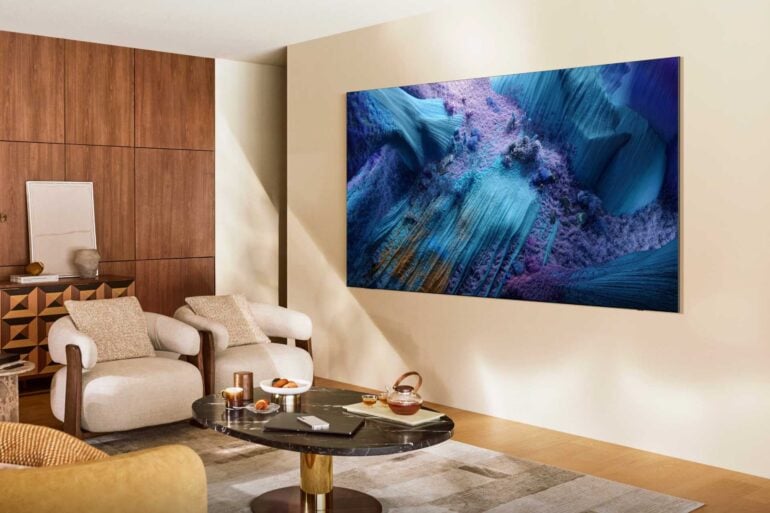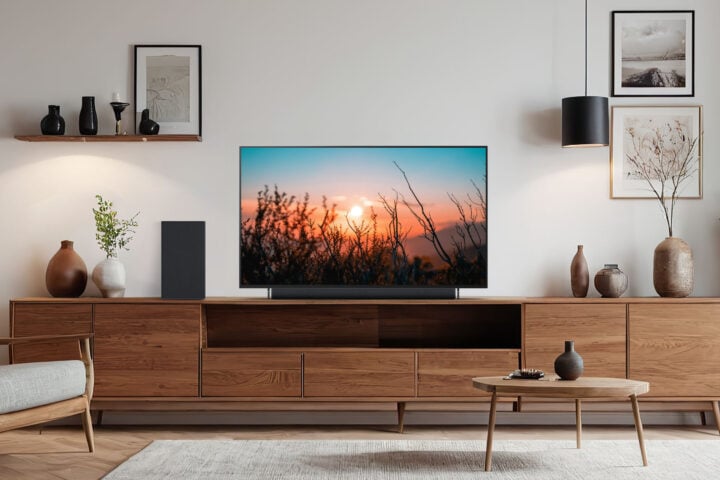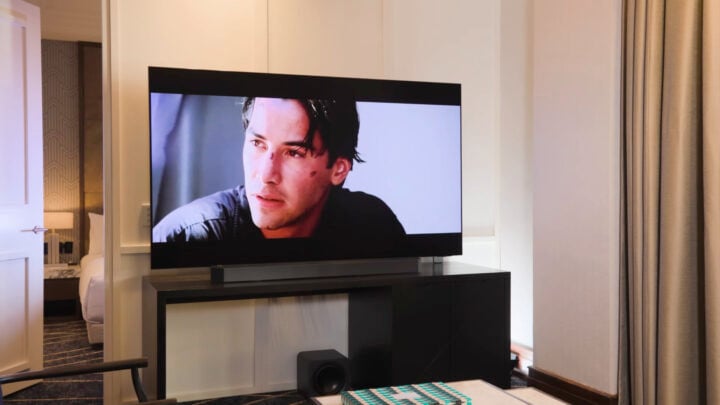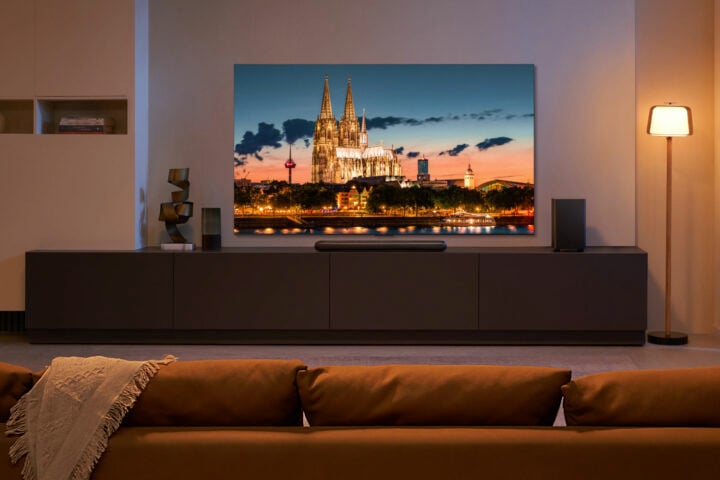
Now that we’ve had a bit of time to try out some of this year’s biggest TVs, we feel comfortable letting you know what’s worth your money. As of mid-2025, these are the best TVs we’ve tested in Australia from the biggest brands.
Buying a new TV can be confusing, with all manner of acronyms and buzzwords to decipher. Using our tips, you’ll know exactly what to look for when visiting the shops. Keen for a big summer of sports viewing? We’ve also got a handy guide on how to choose a great TV for sports.
GadgetGuy tests the locally available TV models in Australia, meaning we review what you can buy off the shelf. Sometimes, TVs share similar model numbers to overseas products, which can be confusing when reading reviews from international publications. Differences between Australian and international TVs can be subtle or drastically different. That’s why it’s so important to test and provide local information so you can make an informed decision.
These are the TVs we’ve tested and recommend across different categories and budgets. An OLED doesn’t always suit everyone’s needs, for example, so a Mini LED might be a better choice. Where possible, we recommend multiple models per category, just in case you find one on sale when the other isn’t.
Read on for a glossary of common TV technologies, including OLED, Mini LED, and LED, to help you find the best TV available in Australia.
Best TV in Australia
Best OLED TV in Australia
LG C5 OLED TV

Price: from $3,295 (55-inch) at JB Hi-Fi
Sitting in the middle of LG’s OLED range, the C5 is an excellent OLED TV for most people. It’s brighter than the B5 and more affordable than the G5, occupying that just-right space.
When Alice Clarke reviewed the LG C5 OLED, she praised its vibrant colours and smooth motion — both of which are hallmarks of any good TV. It produced a beautiful-looking picture replete with the strong contrast OLED panels are known for.
If there’s anything to knock the C5 for, it’s the new AI-infused remote. Gone is the curved Magic Remote of old, replaced with a simpler rectangular block. Oddly, it removed the input button in favour of an AI button, in an effort to push the TV’s assistive features.
But that’s not enough to pry the LG C5 away from the best TV rankings. It’s one heck of a TV for any type of content.
Samsung S95F OLED TV

Price: from $5,299 (65-inch) at Samsung
Another great OLED TV is the Samsung S95F, which is the brand’s latest top model using the pixel-lit technology. Notably, it uses an anti-reflective coating, helping stave off unwanted glare so nearby light sources don’t interfere with your viewing.
As good as OLED TVs are, they’re usually not as bright as other display technologies. That means if any sunlight comes through a window, it’s likely to be noticeable on the screen. Although OLED TVs are getting brighter, Samsung’s solution is to double down on anti-glare tech. In the S95F’s case, its coating diffuses light, getting rid of harsh reflections.
The S95F is also a great gaming TV, capable of pushing refresh rates as high as 165Hz. Games look smooth, there’s a wide viewing angle for multiplayer sessions, and the colours look great.
Best Mini LED TV in Australia
Samsung Neo QLED 8K QN990F

Price: $11,995 (85-inch) via JB Hi-Fi
Read the Samsung QN990F TV review
Samsung has a knack for making excellent Mini LED TVs, and that continues with the QN990F. You might wonder what the fuss is over an 8K TV when there’s not much 8K content around, but this TV does a great job of making lower-res content look stunning. A maximum 240Hz refresh rate also pairs nicely with high-end gaming if you’ve got a decent PC.
Like the S95F, the QN990F also employs Samsung’s anti-glare technology to good effect. Even with the higher maximum brightness of Mini LED backlights, the anti-reflective coating reduces distractions, mainly during dimly lit scenes.
Highlighting its status as a luxury TV, the QN990F taps into Samsung’s Wireless One Connect Box, providing a hub that connects all your inputs neatly. It means you don’t have cables going everywhere behind the TV, which looks less chaotic, particularly if you prefer wall-mounting TVs.
You also can’t go too far wrong with some of Samsung’s other Mini LED TVs, like the QN900F or the 4K QN90F version. Both models are a bit more affordable and come in more sizes.
Best value TV in Australia
We’re currently testing some of 2025’s more affordable TVs, so stay tuned as we update this list.
TCL C855

Price: from $1,995 via JB Hi-Fi
In terms of picture quality, features, and sheer versatility, it’s tough to look past the TCL C855. TCL’s mid-range Mini LED is super bright, reaching more than 3,000 nits at its peak, so it’s great at tackling glare during the day. You can also find the C855 for less than $2,000 during sales, making it the best TV in Australia in terms of value.
Cross-platform compatibility is one of the C855’s biggest strengths. With the Google TV operating system installed, it supports a huge range of streaming apps, giving you plenty of viewing options. In the event you can’t find an app on the TV, the TCL C855 supports both Apple AirPlay and Chromecast without the need for an external dongle. It makes casting videos or photos from an iPhone or an Android handset effortlessly easy.
With a 144Hz panel, the TCL C855 excels as a well-priced gaming TV. Regardless of genre, picture details look crisp while the motion stays smooth. Game consoles that support high refresh rates, like the Xbox Series X and PlayStation 5, are right at home here. The only drawback is that the C855 only has two HDMI 2.1 ports, so you might need to juggle devices if you also want to connect a gaming PC, for example.
Its colours also look deep and vibrant, making the visuals pop from the screen. The factory default settings skew a little too vivid, which is fairly common, but it’s nothing a bit of manual tinkering can’t fix.
Blooming isn’t too much of an issue with the TCL C855 thanks to its decent light control. Roughly 1,300 dimming zones keep a lid on any unwanted halo effects, although it can get a little too aggressive at times. Subtitles occasionally fade at the edges against dark backgrounds, so it’s not quite as precise as an OLED TV.
At this price, however, it’s extremely good value.
Hisense U8NAU
The Hisense U8NAU is almost on par with the TCL C855 in every way. Compared head-to-head, Hisense’s mid-range Mini LED TV is slightly dimmer and has marginally fewer dimming zones. Otherwise, it offers a similar set of features, including a 144Hz panel replete with gaming-centric features.
It pairs nicely with Apple devices, too, supporting built-in Apple AirPlay connectivity. TCL claims the advantage here because it also supports Chromecast for Android devices as part of its Google TV operating system. Meanwhile, the Hisense U8NAU adopts the bespoke VIDAA platform, which works well with a bunch of apps, but isn’t quite as open a platform as Google TV.
Both TVs are great, though, so it’s mainly a question of which one you can find for the cheapest. If your budget doesn’t quite stretch this far, consider either the Hisense U7NAU or the TCL C755. Both models have similar features, albeit with fewer dimming zones
OLED vs Mini LED vs LED: which TV to choose?
With so many buzzwords, acronyms, and tech-heavy jargon to sift through, choosing a TV isn’t easy. One of the biggest points of difference to look out for is a panel’s backlight technology. To help demystify things a bit, let’s explain three of the most prominent TV technologies currently available.
Starting with LED, or light emitting diode, TVs with this type of backlight tend to be the most affordable. They’re cheaper to manufacture and therefore get used in most entry-level models.
There tends to be two main types of LED TVs: edge-lit, and full-array. Edge-lit, as the phrase suggests, sees the LED backlights positioned around the edges of the display.
TVs like the LG QNED81 use this technology, which helps keep the cost down. It does mean you encounter blooming, where a halo-like effect appears around a bright subject against a dark background. Meanwhile, full-array LEDs are spread more evenly across the panel, producing a more consistently lit picture.
Mini LED
Mini LED is the next step up, and is currently the brightest mass-market TV technology. These TVs use thousands of rice-grain-sized backlights to produce an image. This creates a greater level of control based on the number of dimming zones a panel has.
Generally speaking, the more premium a TV is, the more dimming zones it’ll have, minimising blooming in the process. Mini LED’s brightness makes it the perfect option for living rooms with lots of natural light and glare, particularly during daytime viewing.
OLED
At the top end is OLED, short for organic light emitting diode. Unlike other technologies, OLED doesn’t rely on dimming zones or individual backlights. This is because it lights up on a per-pixel basis, producing the most precise image of any mainstream TV. There’s little to no blooming on an OLED TV because it can switch pixels on and off as needed.
The drawback is that OLED is more expensive than other types of TVs. It’s also not as bright as Mini LED, which can make things tricky in a well-lit room. Once upon a time, there were fears about OLED burn-in, or image retention issues, where visible image artifacts remained on the screen after prolonged use. These days, the technology has progressed to imperceptibly shift the lit pixels regularly, so it’s only a risk in extreme edge cases.
OLED TVs also consistently have the best contrast, colour representation, and viewing angle. If you want to watch something as the director intended, you’ll likely get the closest depiction on an OLED. On some other TVs, if you miss out on the best seat and watch from an angle, you’ll likely notice a loss of colour and distorted lighting. OLED, on the other hand, produces an almost identical picture no matter where you’re sitting.
With all that in mind, there’s no ‘correct’ TV to choose. Each one has its own set of benefits and drawbacks. Above all else, the two most important things to consider are price and what your main use will be. Keep these factors in mind, and you’ll be happy with whichever TV you pick.
The post Best TV in Australia 2025: LG, Samsung, Hisense, TCL compared appeared first on GadgetGuy.



0 (mga) komento:
Mag-post ng isang Komento